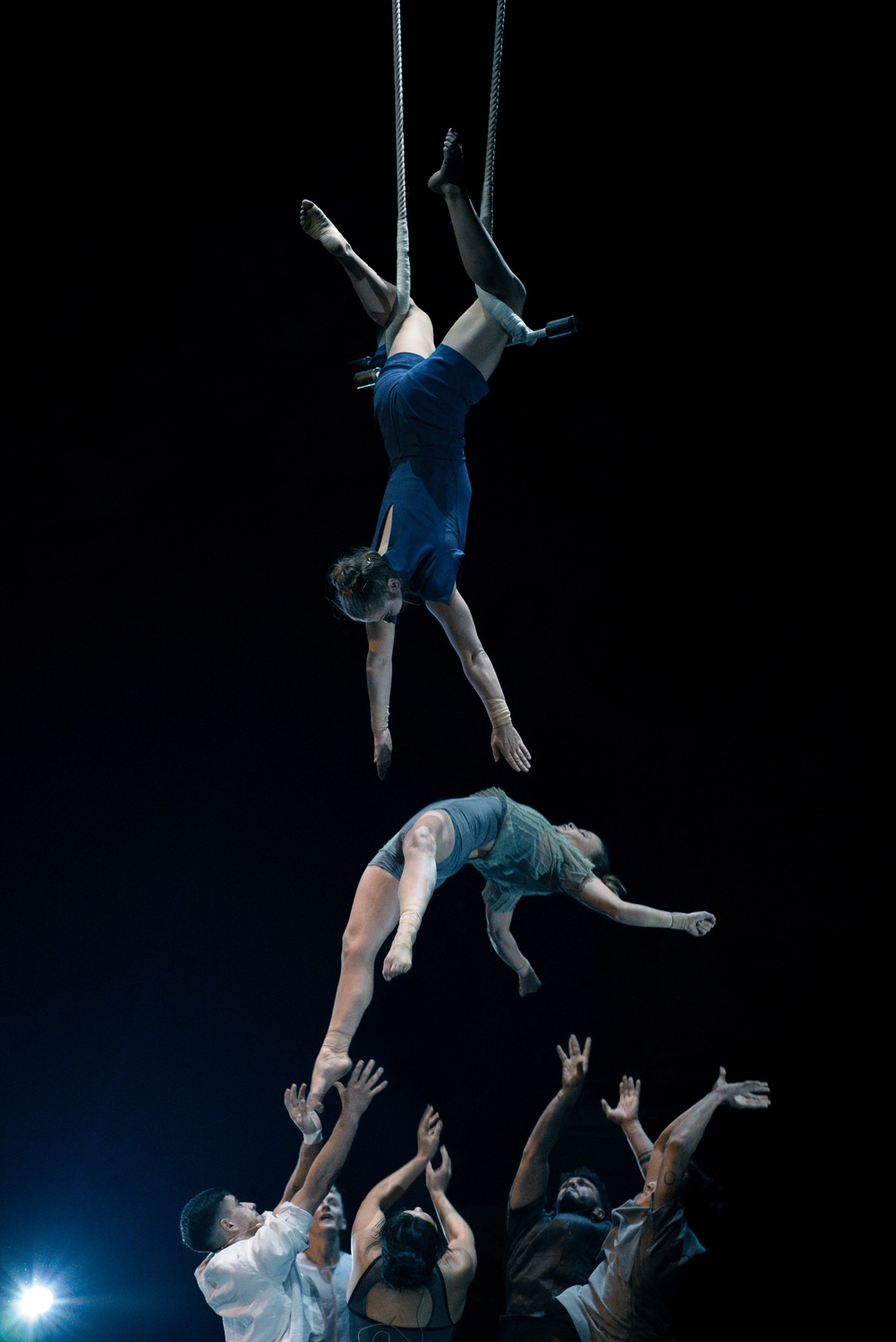
News
Summers Will Not Finish Semester of Teaching as Harvard Investigates Epstein Ties

News
Harvard College Students Report Favoring Divestment from Israel in HUA Survey

News
‘He Should Resign’: Harvard Undergrads Take Hard Line Against Summers Over Epstein Scandal

News
Harvard To Launch New Investigation Into Epstein’s Ties to Summers, Other University Affiliates

News
Harvard Students To Vote on Divestment From Israel in Inaugural HUA Election Survey
‘Passengers’ Review: Reaching New Heights but Lacking Depth

When watching someone fall from a great height onstage, that brief moment while their body plummets lasts an eternity. Even when the brain chimes in, rationally, that the actors rehearsed this successfully a thousand times, it can’t quell the terror that seeps in nonetheless. Fear, excitement, anticipation thrum excitedly, until just as quickly, the moment’s over. Relief kicks in. All that’s left is the thought, “How on earth did they do that?”
At its best, “Passengers” at the American Repertory Theater provides that exhilarating feeling again and again. Unfortunately, the story connecting these moments into a 90 minute stage production fails to match those heights.
Produced by Canadian physical-theater troupe The 7 Fingers and written, directed and choreographed by their co-founder Shana Carroll, “Passengers” aims to capture transit and travel as a metaphor for a journey through life itself. Carroll’s production sometimes swings and misses, but still makes an impression.
The best parts of “Passengers” are its cheekiest. A clever number spotlighting performer Santiago Rivera follows a restless train rider whose juggling corresponds to a canon of coughs, jolts, and page turns. Once Rivera takes off, juggling an increasing number of balls, the cast transforms into fascinated spectators. Simultaneously, the lighting by Éric Champoux washes the stage in purple and syncs to an energetic hip-hop track.
Still more spectacular is the hand-to-trap number, a discipline created by Carroll that combines trapeze work with partnered acrobatics. Performers Eduardo De Azevedo Grillo and Marie-Christine Fournier mimic the uncomfortable jostling between two passengers in close quarters while sitting together on the trapeze. Their jostling turns into increasingly stunning feats as Grillo and Fournier balance atop one another and perform incredible throws. Impressive and clever all at once, the sequence provides a new perspective on a relatable experience — offering up what good can come out of an unlikely and even uncomfortable first encounter.
Seriousness, however, does not play as well. During the contemplative numbers, Carroll’s choreography, while elegant, falls short of commentating on the thought-provoking themes of “Passengers” and just evokes them. Some of the choreographed movements even over-express to the point of humor. At multiple points the cast perform an exaggerated running-in-place pantomime, a motion so on the nose it elicits a pained chuckle. These dramatic sequences climax with impressive tricks all the same as the comedic ones, but lack a decisive bite or perspective.
These less obvious scenes could have been made clearer with a stronger musical and technical hand. Composer Colin Gagné’s underscoring leans towards melodrama. Soapy string sections swell but never fully soar. Simultaneously, the projections by Johnny Ranger often distract from the actors’ staging with cluttered imagery that similarly lacks narrative edge.
Amanda Orozco’s aerial silk performance suffers from this issue in particular. Projected bridges behind her make the silks difficult to see and interfere with Champoux’s lighting, obscuring her movements. Similarly, while the truss bridge and the aerial silk have visual similarities, the greater connection between the two is left too open-ended and the nondescript music doesn’t help.
These problems are only magnified by the few songs that don’t have any choreography or cirque sequences. Two songs, performed by Isabella Diaz, bring the show to a screeching halt. The first, a Jason Mraz-esque ukulele number, gets by with lyrics full of platitudes and a forgettable melody. The second, a mournful ballad about forced migration, similarly trudges along with lyrics full of stock phrases. During the song, other cast members shine handheld lights on Diaz which do not illuminate her particularly well, rendering the stage as dim and featureless as the ballad itself.
Nevertheless, even when the script and music fail to evoke serious emotion, the cast’s incredible skills still entertain. As they perform trick after death-defying trick, their smiles remind the audience that what’s happening on the stage is only possible at the peak of human athleticism and they do it with ease. It’s only a shame that the thematic infrastructure can’t catch up.
“Passengers” runs at the Loeb Drama Center in Cambridge through Sep. 26.
—Staff writer Ria S. Cuellar-Koh can be reached at ria.cuellarkoh@thecrimson.com. Follow her on X @riacuellarkoh.
Want to keep up with breaking news? Subscribe to our email newsletter.
